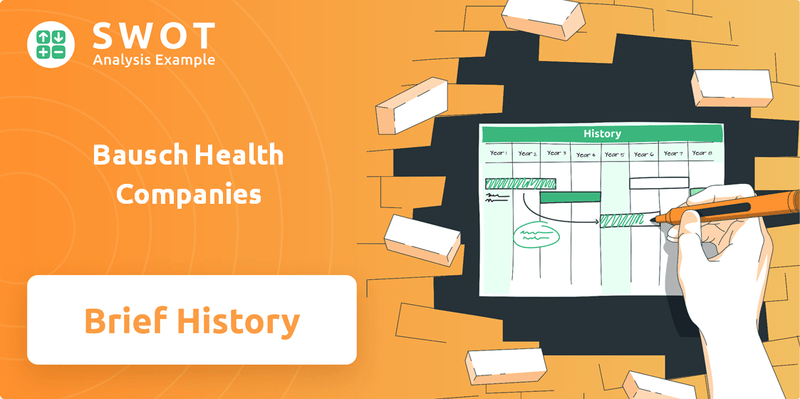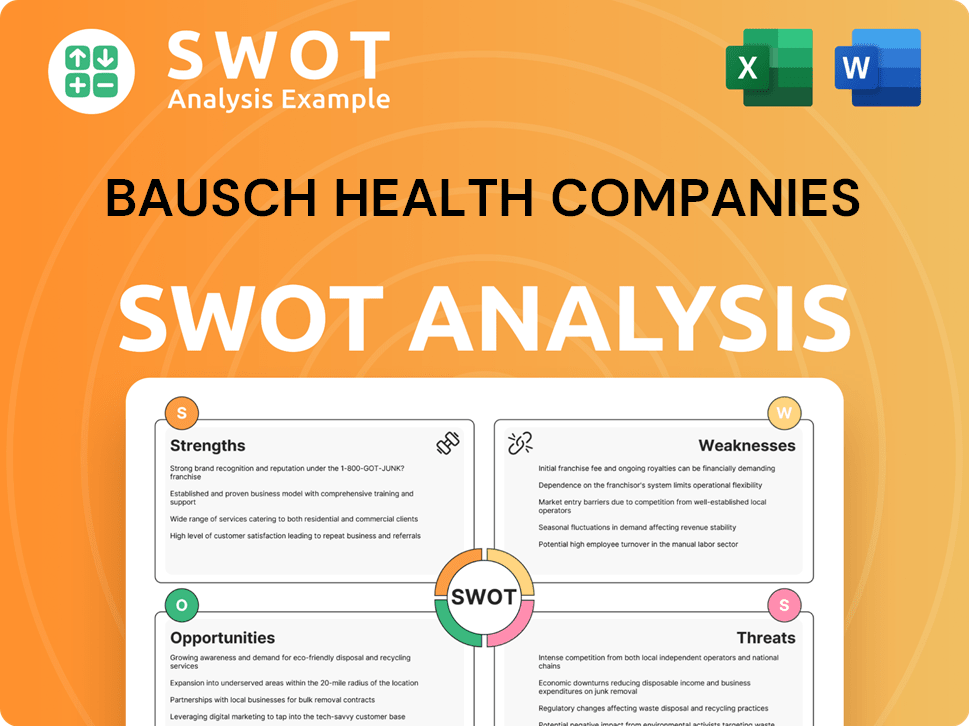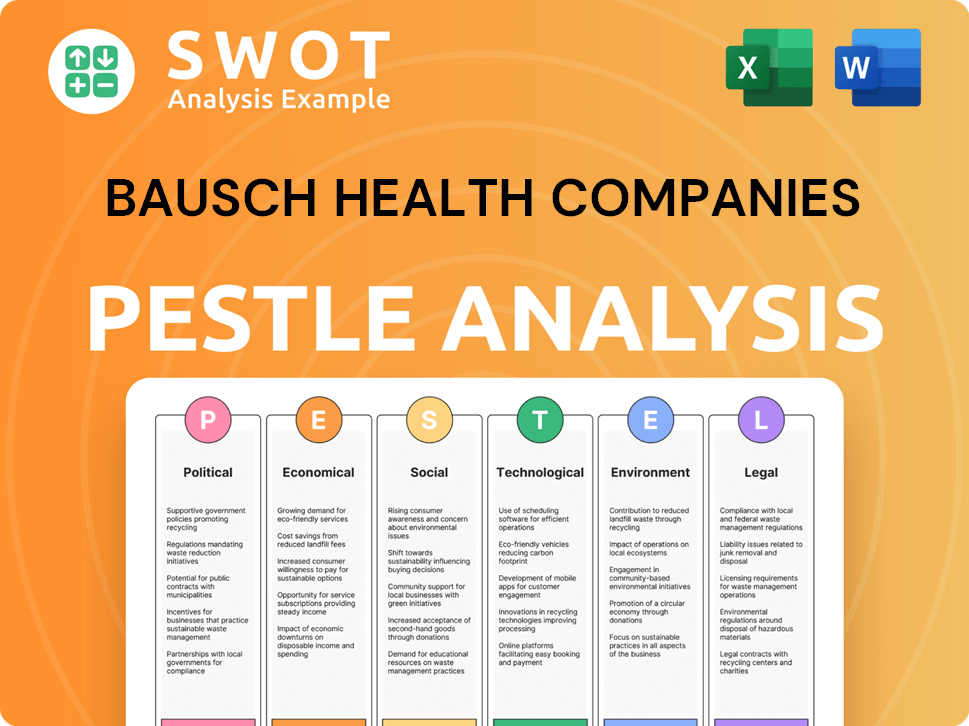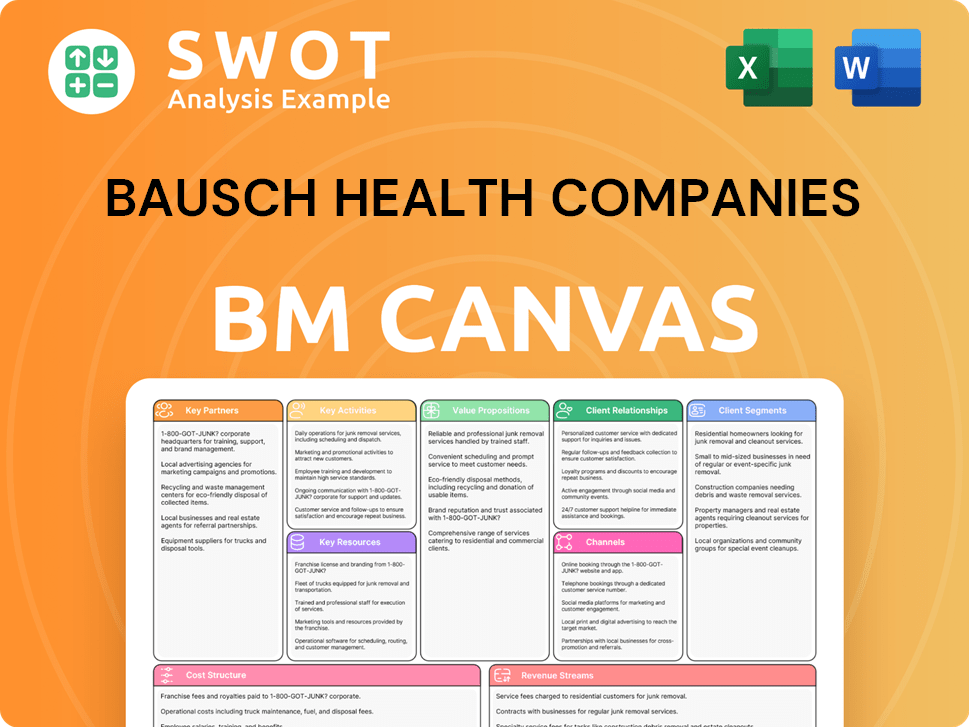Bausch Health Companies Bundle
How did Bausch Health Companies Evolve?
Journey back in time to uncover the fascinating Bausch Health Companies SWOT Analysis and its remarkable transformation. From its roots in 1853 as a small optical shop in Rochester, New York, to its current status as a global healthcare leader, the BHC company's story is one of innovation and strategic adaptation. Explore the key milestones that shaped this pharmaceutical company and its impact on the healthcare landscape.

Delving into the Bausch Health history reveals a compelling narrative of resilience and strategic shifts, including its association with Valeant Pharmaceuticals. Understanding the Bausch Health Companies timeline and its evolution provides valuable insights into its market position and future prospects. This journey highlights the company's adaptability and its continuous efforts to meet the evolving needs of the healthcare industry, making it a key player to watch.
What is the Bausch Health Companies Founding Story?
The story of Bausch Health Companies Inc. begins in October 1853. It was when John Jacob Bausch, a German immigrant, opened an optical goods shop in Rochester, New York. This marked the start of what would become a major player in the pharmaceutical industry.
Bausch, who arrived in the U.S. with only 60 cents, aimed to make eyeglasses more affordable. He saw the high cost and fragility of existing eyewear as a problem. His vision was to provide accessible and durable eyewear to the public.
The initial business model revolved around creating affordable eyeglasses using vulcanite rubber. This innovative approach allowed for lower prices compared to competitors. This early focus set the stage for the future growth of Bausch Health Companies.
John Jacob Bausch founded the company in 1853, focusing on affordable eyewear. His initial capital was limited, starting with just 60 cents. The partnership with Henry Lomb in 1861, forming 'Bausch & Lomb,' was crucial.
- John Jacob Bausch, a German immigrant, started the business.
- He identified the need for affordable eyeglasses.
- The use of vulcanite rubber was a key innovation.
- A $60 loan from a friend was essential for early funding.
In 1861, Bausch partnered with Henry Lomb, which led to the formation of 'Bausch & Lomb.' This partnership provided additional capital and expertise. The early funding came from bootstrapping and a crucial loan, highlighting the challenges faced during its establishment. The mid-19th century, with its increasing industrialization, influenced the company's creation. This positioned Bausch & Lomb to address a clear market need. For more on the company's strategies, see the Marketing Strategy of Bausch Health Companies.
The company's early focus on affordability and durability set the foundation for its future. This focus helped it to meet the growing demand for consumer goods. The early years were marked by innovation and a commitment to serving the public's needs. This laid the groundwork for the company's expansion and development in the pharmaceutical sector.
Bausch Health Companies SWOT Analysis
- Complete SWOT Breakdown
- Fully Customizable
- Editable in Excel & Word
- Professional Formatting
- Investor-Ready Format

What Drove the Early Growth of Bausch Health Companies?
The early growth of Bausch & Lomb, now part of Bausch Health Companies, was marked by rapid expansion beyond its initial optical shop. This growth included diversification into scientific instruments and photographic lenses. The company's commitment to innovation and quality established it as a leader in precision optics during the late 19th and early 20th centuries. This period laid the foundation for its future in the pharmaceutical industry.
Key acquisitions and mergers played a vital role in the expansion of Bausch Health Companies. The company strategically pursued new markets by diversifying into products like binoculars and telescopes. During World War I and World War II, Bausch & Lomb became a major supplier to the U.S. military, which significantly boosted its production capacity and technological advancements. This period also saw the expansion of its team, moving from a partnership to a more structured corporate entity.
A pivotal moment in Bausch Health history was the development of soft contact lenses. This innovation, licensed in the late 1960s, revolutionized eye care and propelled the company into a new era of growth. The market reception to soft contact lenses was overwhelmingly positive, transforming Bausch & Lomb into a household name in vision care. This demonstrated the company's ability to capitalize on groundbreaking scientific advancements.
The strategic shift towards soft contact lenses was a crucial entry into a new product category. This move significantly shaped the future of the company. The success of this product line highlighted the company's capacity to adapt and lead in emerging markets. For more insights into the company's trajectory, consider exploring the Target Market of Bausch Health Companies.
While specific financial data from the early periods of Bausch Health history is limited, the company's growth trajectory suggests a robust financial performance. The expansion into new markets and product lines, such as microscopes and photographic lenses, likely contributed to increased revenue streams. The company's strategic moves in the early 20th century, including supplying the U.S. military, further supported its financial growth.
Bausch Health Companies PESTLE Analysis
- Covers All 6 PESTLE Categories
- No Research Needed – Save Hours of Work
- Built by Experts, Trusted by Consultants
- Instant Download, Ready to Use
- 100% Editable, Fully Customizable

What are the key Milestones in Bausch Health Companies history?
The history of Bausch Health Companies, formerly known as Valeant Pharmaceuticals International, is marked by significant achievements, strategic shifts, and periods of intense scrutiny. The company has navigated through transformative changes, including major acquisitions, restructuring efforts, and a rebranding, to redefine its position in the pharmaceutical industry. This journey reflects its evolution from a company focused on aggressive growth to one prioritizing sustainable practices and rebuilding stakeholder trust. For further insights, you can explore the Mission, Vision & Core Values of Bausch Health Companies.
| Year | Milestone |
|---|---|
| 1971 | Bausch & Lomb introduced the first soft contact lenses, revolutionizing vision correction. |
| 2013 | Valeant Pharmaceuticals acquired Bausch & Lomb for approximately $8.7 billion. |
| 2016 | The company faced scrutiny over drug pricing and business practices, leading to a significant decline in its stock price. |
| 2018 | Valeant Pharmaceuticals International changed its name to Bausch Health Companies Inc. as part of a restructuring. |
| 2021 | Bausch Health completed the divestiture of Amunani to Novartis for roughly $7.6 billion. |
| 2022 | Bausch + Lomb, the eye health business, was spun off into an independent publicly traded company. |
Bausch Health has been at the forefront of innovation, particularly in eye care and pharmaceutical formulations. The introduction of soft contact lenses by Bausch & Lomb in 1971 was a groundbreaking achievement, setting a new standard in vision correction. The company's commitment to research and development has consistently led to advancements in optical technologies and pharmaceutical products.
Bausch & Lomb's introduction of soft contact lenses in 1971 was a pivotal innovation, transforming vision correction. This innovation provided a more comfortable and versatile alternative to traditional eyeglasses and rigid contact lenses.
The company has consistently advanced optical technologies, including microscopes and photographic lenses. These innovations have improved the quality and precision of vision-related products.
Bausch Health has developed various pharmaceutical formulations to treat various conditions. These formulations have expanded the company's product portfolio and addressed unmet medical needs.
The acquisition of Bausch & Lomb in 2013 was a strategic move to strengthen its position in the eye care market. This acquisition expanded its product offerings and market reach.
The company has undertaken significant restructuring and divestitures to streamline operations and reduce debt. These actions have helped Bausch Health focus on core therapeutic areas and improve its financial health.
The spin-off of Bausch + Lomb into an independent publicly traded company in May 2022 was a strategic decision. This move allowed both entities to pursue their growth strategies independently.
Bausch Health has faced considerable challenges, particularly during its time as Valeant Pharmaceuticals. Aggressive drug pricing strategies and an acquisition-heavy growth model led to significant controversies and financial difficulties. The company's stock price plummeted, and it faced investigations and a loss of investor confidence.
Controversies over drug pricing, including increases for drugs like Isuprel and Nitropress, led to congressional inquiries and public criticism. These pricing strategies damaged the company's reputation and financial performance.
The company's reliance on acquisitions to fuel growth resulted in high debt levels and integration challenges. This strategy proved unsustainable and contributed to financial instability.
The controversies and financial challenges led to a significant decline in the company's stock price, impacting investor confidence. The stock performance reflected the severity of the issues faced.
The company underwent significant restructuring and rebranding to address its challenges and rebuild trust. This included changing its name to Bausch Health in 2018.
Bausch Health has focused on reducing its debt through divestitures and improved financial management. The divestiture of Amunani in 2021 was a key step in this direction.
The controversies and financial difficulties led to a significant loss of investor confidence. Rebuilding trust with investors has been a key focus for the company.
Bausch Health Companies Business Model Canvas
- Complete 9-Block Business Model Canvas
- Effortlessly Communicate Your Business Strategy
- Investor-Ready BMC Format
- 100% Editable and Customizable
- Clear and Structured Layout

What is the Timeline of Key Events for Bausch Health Companies?
The journey of Bausch Health Companies, a prominent pharmaceutical company, began in 1853 with John Jacob Bausch's optical goods store, evolving significantly over time. The company's evolution includes key milestones such as the introduction of soft contact lenses in 1971 and the acquisition by Valeant Pharmaceuticals International in 2010. The BHC company later rebranded to its current name in 2018, marking a shift in strategy. The divestiture of Amunani in 2021 and the spin-off of the eye health business in 2022 further reshaped the company's focus. Understanding the Growth Strategy of Bausch Health Companies provides additional insights into its strategic shifts.
| Year | Key Event |
|---|---|
| 1853 | John Jacob Bausch opens an optical goods store in Rochester, New York, marking the beginning of the company's history. |
| 1861 | Henry Lomb joins as a partner, forming Bausch & Lomb, which would become a significant name in the industry. |
| 1874 | The company begins manufacturing microscopes, expanding its product offerings beyond optical goods. |
| 1971 | Bausch & Lomb introduces the first soft contact lenses, revolutionizing the eye care market. |
| 2010 | Valeant Pharmaceuticals International acquires Bausch & Lomb, initiating a period of significant corporate changes. |
| 2015 | Valeant faces scrutiny over drug pricing and business practices, leading to a period of restructuring. |
| 2018 | Valeant Pharmaceuticals International rebrands as Bausch Health Companies Inc., signaling a new direction. |
| 2021 | Divestiture of Amunani to Novartis completed for approximately $7.6 billion, streamlining its portfolio. |
| 2022 | Bausch + Lomb eye health business is spun off into an independent publicly traded company, refocusing the core business. |
| 2023 | Bausch Health continues to focus on its core therapeutic areas, including gastroenterology, dermatology, and select eye health products. |
| 2024 | The company is working towards further reducing its debt and strengthening its balance sheet. |
| 2025 | Bausch Health aims to leverage its existing product portfolio and pipeline to drive sustainable growth. |
Bausch Health is actively focused on reducing its debt, a key priority as of early 2024, aiming to improve its financial position. The company's strategy involves deleveraging and strengthening its balance sheet to ensure long-term sustainability.
The company concentrates on core areas such as gastroenterology, dermatology, and specific eye health products. This focus allows for specialized treatments and targeted research and development, which is crucial for growth.
The increasing demand for specialized treatments in gastroenterology and dermatology creates favorable market conditions. An aging global population also presents opportunities for growth, particularly in healthcare. These trends are likely to positively impact the company's future.
Leadership is committed to operational efficiency and strategic investments in research and development. This approach aims to leverage existing brands and pipelines to deliver value and drive sustainable growth in the pharmaceutical sector.
Bausch Health Companies Porter's Five Forces Analysis
- Covers All 5 Competitive Forces in Detail
- Structured for Consultants, Students, and Founders
- 100% Editable in Microsoft Word & Excel
- Instant Digital Download – Use Immediately
- Compatible with Mac & PC – Fully Unlocked

Related Blogs
- What is Competitive Landscape of Bausch Health Companies Company?
- What is Growth Strategy and Future Prospects of Bausch Health Companies Company?
- How Does Bausch Health Companies Company Work?
- What is Sales and Marketing Strategy of Bausch Health Companies Company?
- What is Brief History of Bausch Health Companies Company?
- Who Owns Bausch Health Companies Company?
- What is Customer Demographics and Target Market of Bausch Health Companies Company?
Disclaimer
All information, articles, and product details provided on this website are for general informational and educational purposes only. We do not claim any ownership over, nor do we intend to infringe upon, any trademarks, copyrights, logos, brand names, or other intellectual property mentioned or depicted on this site. Such intellectual property remains the property of its respective owners, and any references here are made solely for identification or informational purposes, without implying any affiliation, endorsement, or partnership.
We make no representations or warranties, express or implied, regarding the accuracy, completeness, or suitability of any content or products presented. Nothing on this website should be construed as legal, tax, investment, financial, medical, or other professional advice. In addition, no part of this site—including articles or product references—constitutes a solicitation, recommendation, endorsement, advertisement, or offer to buy or sell any securities, franchises, or other financial instruments, particularly in jurisdictions where such activity would be unlawful.
All content is of a general nature and may not address the specific circumstances of any individual or entity. It is not a substitute for professional advice or services. Any actions you take based on the information provided here are strictly at your own risk. You accept full responsibility for any decisions or outcomes arising from your use of this website and agree to release us from any liability in connection with your use of, or reliance upon, the content or products found herein.